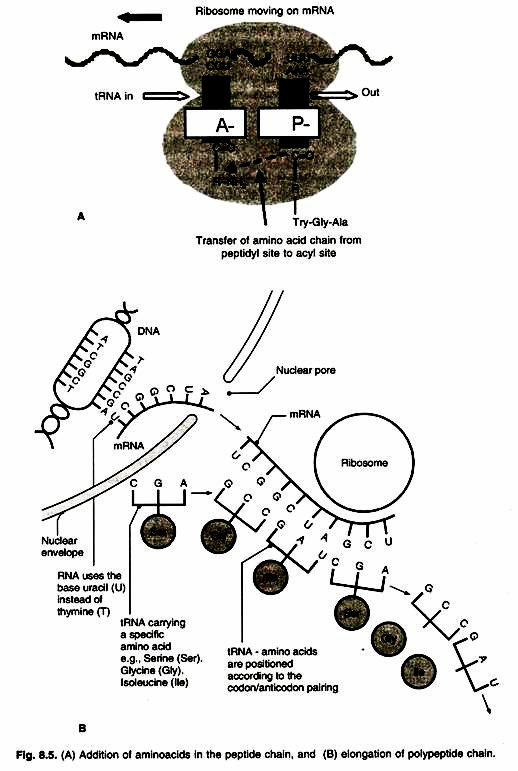In this article we will discuss about the important features in the life history of filarial worm (explained with diagram).
Filarial worm is a dreaded human parasite of blood and lymph. It is a digenetic parasite completing its life cycle in two hosts—man and mosquito.
Copulation and release of microfilariae in man:
Man is the only definitive host, in whose lymphatic system the adult worms are harboured. Copulation takes place when individuals of both sexes are found in the same lymph gland. Ovoviviparous females and males lie coiled in the lymph nodes. Female releases numerous juveniles called microfilariae.
They are born in a very immature state, being in-fact embryos rather than juveniles. The microfilariae are about 0.2 to 0.3 mm long, surrounded by a delicate cuticular sheath and containing rudiments of various adult structures (Fig. 13.4).
The female worm gives birth to a large number of microfilariae (about 1,000) which appear in peripheral blood only during the night usually between 10.00 pm and 2 am. During the day they are rarely observed in blood. The appearance of microfilariae in the peripheral blood exhibits nocturnal periodicity.
Larvae reach their maximum concentration in the blood about midnight whereas during the daytime the embryos are concentrated in the lungs. The nocturnal periodicity may be related to the diurnal variations in the activity of the host.
Bahr opined that the nocturnal periodicity of microfilaria in peripheral blood of man is an adaptation to maintain a tryst with the night biting species of Culex mosquito. Microfilariae in human blood eventually die unless ingested by the mosquitoes.
Development of microfilariae in mosquito:
Further development in the microfilariae occurs only when they are ingested by a female mosquito. The intermediate or secondary host is a mosquito, in which the microfilariae undergo for their development after which they become infective to man.
The females of Culex, Aedes, and even Anopheles can serve as intermediate hosts for W. bancrofti, but Culex is the most common intermediate host and transmitting agent (Fig. 13.5).
In the stomach of mosquito the microfilariae cast off their sheaths, penetrate the stomach wall and migrate to thoracic muscles or wing musculature where they undergo metamorphosis and begin to grow within 2-6 hours of the blood meal.
In the next two days they change first to a plump sausage-shaped organism with a short spiky tail, measuring 124-250 μm in length by 10-17 μm in breadth (the first stage larva). It possesses a rudimentary alimentary canal.
In three to seven days-time the first stage larva grows rapidly and undergoes moulting once or twice to become a more elongated form (second stage larva), measuring 225-330 μm in length by 15-30 μm in breadth. On about 10—11th day the metamorphosis becomes complete and the tail atrophies. Here the body shortens to half its original length but the digestive tract, body cavity and genital organs differentiate and the worms begin to grow in length as well as girth, eventually measuring about 1,500 to 2,000 μm by 20 to 30 μm.
During this time there have been two moults and the larvae have reached the infective stage (third stage larva). The formation of the infective stage takes about 10-12 days and occurs best at 27-28°C and a relative humidity of 90 per cent. The infective larva of W. bancrofti is a filariform larva.
At best only a small percentage of the microfilariae ingested by the mosquito develop into infective larvae. It should be noted that one microfilaria gives rise to one infective larva in the proboscis sheath of the mosquito. There may be several larvae remaining coiled up, waiting for an opportunity to infect man (the definitive host) while the mosquito is having its blood-meal.
Infection of new human host and development into new adult worms:
When this mosquito pierces its proboscis into human being, the third stage larvae are not directly injected into the blood stream like malarial parasites, but are deposited on the skin near the puncture site. The larvae then enter through the puncture wound or penetrate through the skin on their own.
The third stage larvae, having penetrated the skin, enter the lymphatic vessels and are carried usually to inguinal, scrotal or abdominal lymphatics and begin to grow into adult worms. There is no multiplication at this stage and only one adult male or female develops from one larva. They become sexually mature in about 5-18 months and mate.
The male worm fertilizes the female worm and the gravid female worm discharges about 50,000 microfilariae per day. The microfilariae pass through the thoracic duct or the right lymphatic duct to the venous system and pulmonary capillaries and then to the peripheral circulation, thus completing the life cycle.


